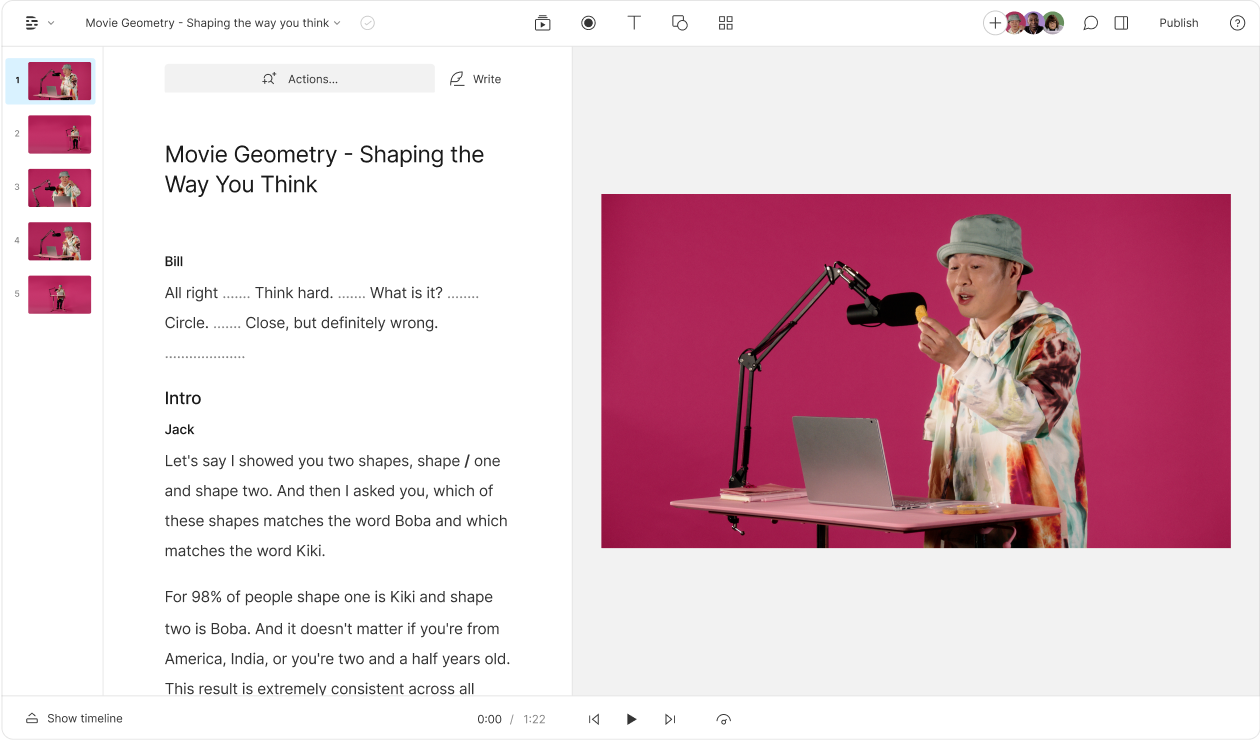What type of content do you primarily create?




We wrote this article with the help of ChatGPT. To do that, we followed the lessons we're sharing with you now: we gave it several blog posts and newsletters on which to model its writing, the Underlord help page to source its knowledge, and plenty of direction and detail to ensure it wrote what we wanted it to write. We then edited the article the same way we would any human-written piece.
When you ask Underlord to edit a video, it doesn’t try to decode the hidden meanings in your prompt. It takes in everything you’ve told it—and everything you haven’t—and tries to do something that fits your intentions. If the result isn’t what you imagined, it doesn't mean you wrote a bad prompt. It probably means you didn't give enough context.
That’s the thing no one tells you when you start using AI tools: It’s not about mastering some arcane language of the machine. It’s about helping the machine understand your language—your project, your audience, your vision, your “this makes sense in my head but not when I say it out loud” creative impulse.
So if you want Underlord to make better edits? Don’t worry about getting better at prompting. Get better at explaining what you’re trying to make.
Think of Underlord as a collaborator, not a mind reader
You wouldn’t hand a human editor a pile of footage and say “just make this shorter.” (Or if you did, you wouldn’t expect them to nail the tone and pacing you wanted on the first pass.) Instead, you'd explain:
- What the video is for
- Where it’s going to live
- Who’s going to see it
- What you want them to feel or do when it ends
Underlord works the same way. It’s not listening for a single magic phrase—it’s listening for purpose. Direction. Context.
If you've read our guide to getting started with Underlord (you should), you may recall that Descript software engineer Katrina Lui puts it like this:
“Instead of saying ‘cut this down,’ try something like ‘make this a fast-paced highlight reel for TikTok with a humorous tone, that’s less than 60 seconds.’”
Going beyond "make this more engaging"
AI editing tools can’t read your mind. They can only read your text. And if that text is vague, you’re going to get vague results.
So when you say: “Make this more engaging,” Underlord needs to know: for whom? For TikTok teens or corporate LinkedIn lurkers? Do you mean funnier? Faster? More animated? All of the above?
To be clear: Underlord will take your "more engaging" prompt and do something. Most likely it will default to some basic, universal(ish) edits like adding music, captions, visual variety, and so on. Better than nothing for sure—especially if you're not sure what would make it more engaging.
But what you are, or ought to be, sure of is who your audience is, where they'll see it, and what you hope to accomplish.
That specificity matters. Underlord is great at figuring out the how—but it needs your help with the why.
Five things Underlord needs to know
The best AI collaborators aren’t the ones with a bag of secret prompt tricks—they’re the ones who know how to explain what they’re trying to do.
So how do you do that, exactly?
Here’s a cheat sheet:
- Tell Underlord what kind of video you're making. “This is a teaser for a longer YouTube interview.” “This is a social post announcing a new product.” “This is a recruiting video for people who are sick of recruiting videos.”
- Name the platform. TikTok wants a fast hook. Instagram likes drama. YouTube Shorts needs vertical orientation. If you tell Underlord, it will adapt.
- Explain the tone. “Serious but hopeful.” “Casual and funny, but not cringe.” “Like if Radiolab and the Muppets made a startup announcement.”
- Clarify the audience. Are you speaking to your peers? Your customers? Strangers in an algorithmic void?
- Say what success looks like. “The viewer should want to click through to watch the full version.” “The viewer should laugh and send this to their friends.” “The viewer should feel seen (and maybe slightly attacked).”
Here's an example
Let’s say you’ve recorded a podcast and you want to turn it into a short, shareable clip. Here’s how different prompts play out:
| Prompt | Result |
|---|---|
| “Cut this into a short video.” | You’ll get… a short video. Probably not a bad one! But maybe not one that’s ready for primetime. |
| "Turn this into a 45-second TikTok with an upbeat tone for an audience of video game fans. Include captions, a fast cut pace, and a punchline at the end. The viewer should laugh and decide to follow my account for more." | Now Underlord knows what to cut, what to keep, and what kind of rhythm to aim for. |
| "Make this a dramatic 2-minute teaser for a longer video, with suspenseful music and a cliffhanger. It should make my audience of serious gamers want to watch the full video and buy the game." | Underlord cues the music, picks a high-stakes moment, and ends on a beat that begs for more. |
Good collaboration requires good communication
It can feel like over-explaining—like adding steps to a workflow that’s supposed to be faster. But the thing is, this was always the job. Creative work has always been about clarity. About vision. About being able to describe the thing you're trying to make — not just to yourself, but to your collaborators.
Underlord just happens to be one of them.
So next time you ask Underlord to help with a video, don’t think: “What’s the right prompt?” Think: “What would I tell a co-editor sitting next to me?” And then... tell it that.























%201.svg)





